Shintō as a distinguished religious belief system from Buddhism, has no fixed dogmas or strict scriptures but more readily preserved and observed through the common social life. Shrine Shintō, Shintō meaning “the way of the kami,” are sacred spaces where people worship the Shintō gods. Shintō rituals stress the harmony between deities, man and nature, thus resulting in locations of “concentrated nature” such as caves, waterfalls, islands and mountains as it was believed that such areas were able to attract and connect with kami.1. Visiting these shrines may occur on a day to day basis with paying respects to the enshrined kami as well as special events such as New Years, seasonal festivals, weddings and many more. The relationship between kami and shrine could be extrapolated to “the universally-oriented Christian churches, based on the faith that god in the subject and the universe is the object in creation.”2 However in the case of Chōsen jingū, State Shinto was separated from religion thus considering shrines as “non-religious” entities. Worshiping of the Japanese deities was viewed as less of a religious act and more of expression of patriotism. The introduction of State Shinto was characterized as “civic,” and a “moral and ethical basis of the nation,”3 thus making the developments less contradictory and confrontational. This was problematic as it stripped the rich history and essence of a shrine not only in the new context but in Japan as well, thus resulting in a “historical monument.”4
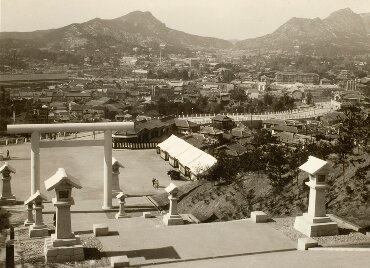
By examining Chōsen Jingū in Korea, one can begin to understand the use of religion, or absence of, in pair with religious establishments to implement colonial power as they shift in objective. Ogasawara noted a clear distinction between Shinto Shrines as overseas developments, for the primary purpose of Japanese immigrants continuing to worship their deities from afar opposed to “colonial/militaristic shrines” which were tools absorbed by the total war regime to carry out authority and devotion. The relationship between Shinto Shrines and the political agenda of Imperial Japan during the thirty-five year-long colonial era was a social setting to introduce Shinto Shrines in that sense were a social setting used to “introduce emperor-centered ideology and mobilize imperial subjects,” through the lens of “Shinto or nationalistic Shinto ideology… to facilitate the so-called peaceful offensive of Japanese military expansion.”5 This “non-violent”6 supremacy was achieved through the infiltration and dependency on education institutions.
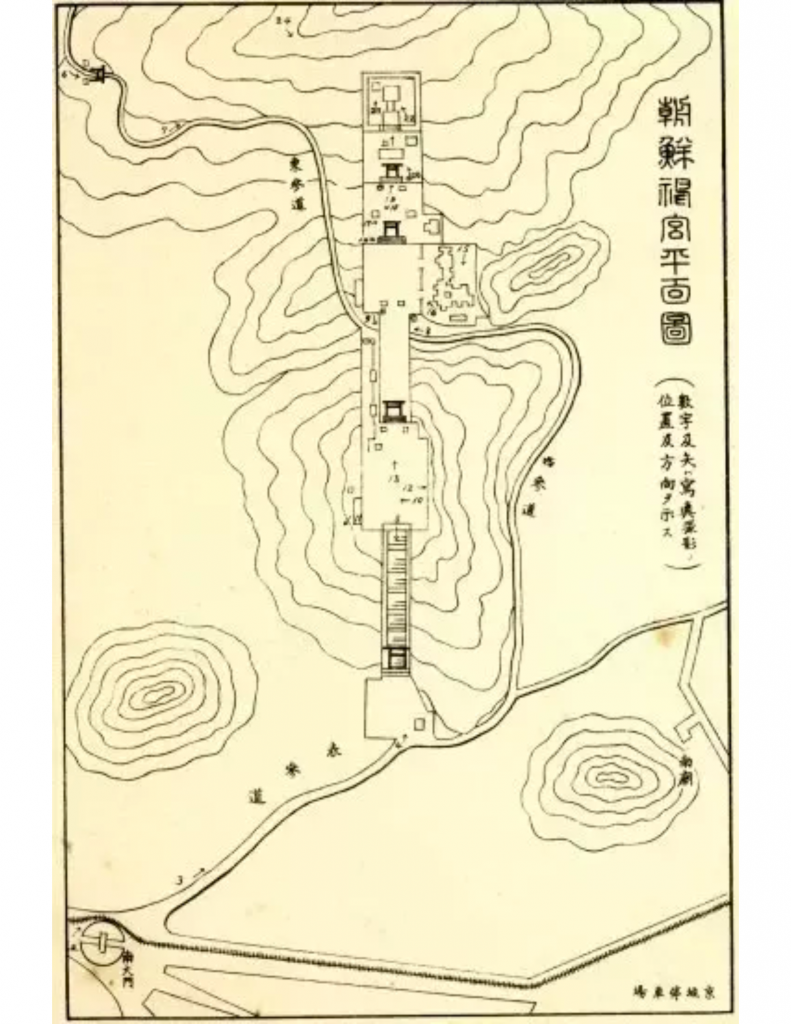
Chōsen Jingū, built in 1925 by Itō Chūta, can be classified as an Imperial Shrine as it was funded by the government during the State Shinto era. It was erected at the peak of Namsan Mountain in Keijō, known today as the Seoul Special City. It was dedicated to Amaterasu, the Sun Goddess in Japanese mythology, and Emperor Meiji and for that reason, became the highest ranking shrine in Japanese-ruled Korea. This is significant considering all three prior shrines constructed in Seoul enshrined Kunitsu-kami7 to serve as guardians of pioneers in each respective region. Alongside Amaterasu, the National Association for Shrine Priests originally proposed the name Dangun (Tangun), “the mythical founder of the ancient Korean nation,” to represent “the supposed mythological relations between Korea and Japan in antiquity,”8 while signifying their current relationship. It was common for shrines to incorporate contextual elements considering their connectivity to the surrounding environment. Ogasawara best defines this flexibility by suggesting “to express gratitude for the founding of the United States, the spirit of George Washington should be enshrined in a Shinto shrine replica of the White House; for respect to the great spirit of the “Lord of Electricity,” Thomas Edison should be enshrined in a beautifully illuminated shrine; and wherever in the world Japanese people go, even in the Arctic and the Antarctic, new types of shrine buildings and suitable new rituals and prayers should be invented for particular places.”9 This leads to the notion that Shinto Shrines are able to absorb and adapt to a wide range of contexts thus making it harder to label as foreign entities. Though Itō Hirobumi, the first Japanese Resident-General, declined the proposal and Emperor Meiji was enshrined in lieu, many saw the petition as an acknowledgement of Korean heritage and a certain degree of freedom. This perspective was harmful as it diminishes the oppressive and assimilating characteristics shrines have realistically exuded.
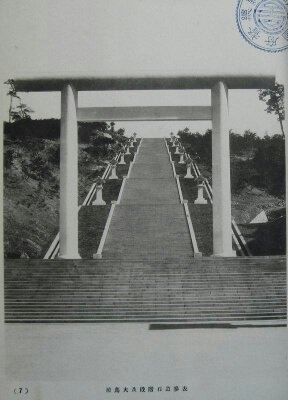
As shrines developed, purposeful buildings were added to accommodate different rituals. Shrines are prime examples of how architecture can be used in controlling the movement of people and monitoring religious reform. Marking the approach and entrance to the sacred land stand one or more torii gates. As depicted in figures 2 and 3, at Chōsen Jinū, towering white torii gates line the spine of stairs and continue along sectioning different stages of the body of the shrine.
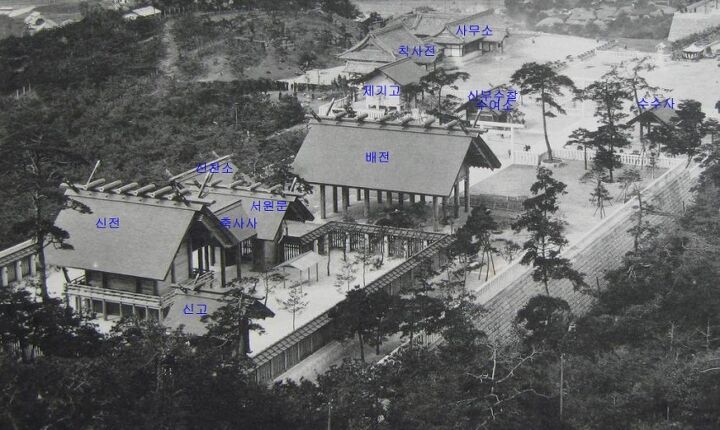
The body of the shrine is typically comprised of housing for local shrine priests, a stage (Kaguraden) for dance or theater performances, a worship hall (Heiden), offering hall (Haiden), and the Sanctuary (Honden) where the resident kami would housed. In the heart of the Honden, sanctified objects which encapsulate the Kami’s spirit are to be contained. These structures, shown in figure 4, are done in the Shinnei-Zukuri10 style. Most easily identified from the steep thatched roofs and wooden earthfast posts. Given the heavy usage of wood, temporality and preservation must be considered. An important feature of Shintō art is the cultivation and preservation of rituals together by relocating building material to other shrines. However, in the situation of “overseas Shinto Shrines,” in colonized Korea, Chōsen jingū as many other shrines erected during the annexation were all destroyed or burned after the liberation, which was a testament to the resentment the Korean’s harboured towards the State Shinto. They even go as far as establishing a memorial for Korean patriots, in particular An Chunggŭn, a Korean nationalist who assassinated the Japanese politician who lead the annexation of Korean.
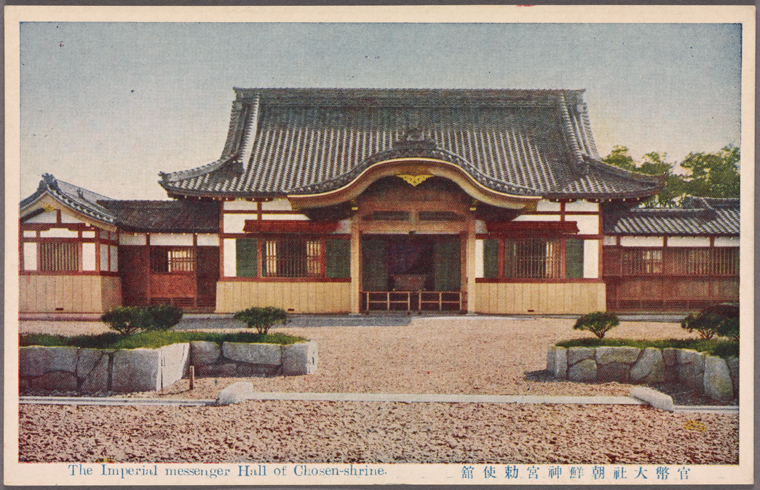
Considering the shrine’s ties to the Imperial family, an Imperial messenger Hall was located on the right directly after the stairs. Its architectural style evolved from Shinnei-Zukuri into a style that resulted from the influence of Buddhism, as shown in figure 5. The landscaping on the shrine grounds were highly manipulated and required consistent maintenance. Funding for landscaping and general maintenance of Chōsen jingū was accomplished through crowdfunding “no doubt partly through coercion – were collected from Korean school children throughout Korea.”11 The demographic that arguably experienced the most conflict with the introduction of Shinto Shrines were already practicing religious groups, in particular Christians. Christian schools faced an ultimatum of succumbing to shrine worship to stay open or closing their doors.
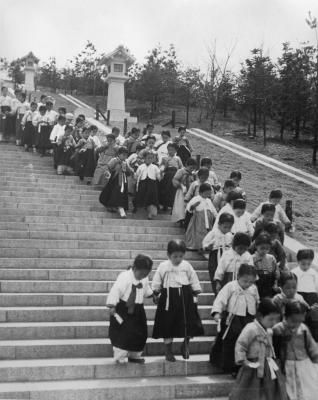
Considering Shintō as less of a structured religion and more of an optimistic faith that promoted moral cultivation; Takamatsu Shirō, the first head priest at Chōsen jingū used this generalization to popularize and enforce State Shinto in a non-confrontational manner. He understood the significant role primary schools were in the disseminating and reinforcing of State Shinto as he argued “primary school students should be made to worship and thus acquire belief, and through this develop a sense of morality…emphasized that shrine worship would nurture a national spirit.”12 The intended results of self-discipline and unity is what many states strive for. “Chōsen jingū continued to serve the site of aggressively mandated worship by students and school administrators and staff,”13 which later extended to the parents of the students. By doing so, introduced Japanese culture and rituals into two central sectors of community life, schools and households. As Kawase noted, “in colonial Korea, State Shinto policy could not be disseminated and reinforced apart from the education system.”14 It could be observed that the success of State Shinto could have only occurred with the dependence on the education system as it was an already established organization that generally concentrated like minded people as well for its ability to connected with all age groups of society. It could also be said that it was pivotal for Shintoists and the government to establish their role during such a crucial stage in one’s development as children are the future of a nation.
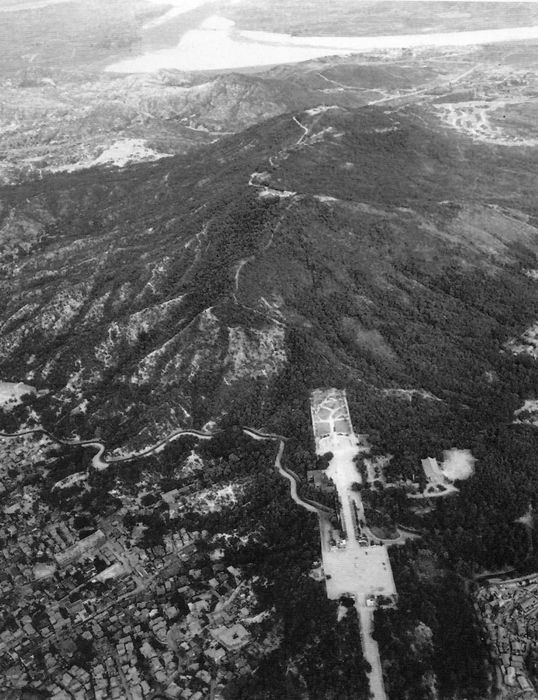
As seen in the aerial photograph, we gain an understand of scale and presence the shrine had in relation to the city and mountain. The physical expanse can be extended to the dominating social and political presence the Shinto State imposed on the citizens. In this instance, the architecture was tactfully dispossessed from its historical context and purpose in attempts to fulfill the modernization of Korea in a indirect approach. This was only achievable due to its interconnectivity with the education system. By doing so lead to a influential introduction, however lacked a sustainable foundation. This could be concluded considering no shinto shrines erected during the annexation of Korea stand in present day.
Notes:
- Kami – Conceptually fluid as could be considered spirits, phenomena, or “holy powers.” Direct Japanese translation for a god, deity, divinity, or spirit.
2. Kōji, 63
3. Kawase, 19
4. Historical Monument – In the sense that the structure will stand frozen in space alienated from its context and original moral values.
5. Kawase, 19
6. Non-violent – In the physical aspect as oppression was heavily applied in a financially coercive and policy implementing approach.
7. Kunitsu-kami – Terrestrial deities. Gods of the Land worshiped by Imperial Family and influential clans.
8. Kōji, 54
9. Kōji, 63
10. Shinnei-Zukuri – An ancient style of Shinto shrine architecture used especially for the main sanctuary. Timber frame structure
11. Kawase, 32
12. Kawase, 32
13. Kawase, 33
14. Kawase, 33
Citations
Delattre, Michele, Kasprowicz, Donna, and Rujivacharakul, Vimalin. “Architecture and Sacred Spaces in Shinto.” https://orias.berkeley.edu/resources-teachers/architecture-and-sacred-spaces-shinto.
Hirai, Naofusa. “Shintō.” Encyclopedia Britannica, November 10, 2020. https://www.britannica.com/topic/Shinto.
Jeon, Sang Sook. “Establishing Japanese National Identity and the “Chosŏn Issue”.” In International Impact of Colonial Rule in Korea, 1910-1945, edited by HA YONG-CHOOL, 49-72. University of Washington Press, 2019. http://www.jstor.org/stable/j.ctvq4bxv9.7.
Kawase, Takaya. “State Shinto Policy in Colonial Korea.” In Belief and Practice in Imperial Japan and Colonial Korea, Edited by Emily Anderson, 19-37. Singapore: Palgrave Macmillan, 2017.
Kim, Sung-Gun. “The Shinto Shrine Issue in Korean Christianity under Japanese Colonialism.” Journal of Church and State 39, no. 3 (1997): 503-21. http://www.jstor.org/stable/23921260.
Kōji, Suga. “A Concept of “Overseas Shinto Shrines”: A Pantheistic Attempt by Ogasawara Shōzō and Its Limitations.” Japanese Journal of Religious Studies 37, no. 1 (2010): 47-74. Accessed April 27, 2021. http://www.jstor.org/stable/27822899.
Maxey, Trent E. “Finding Religion in Japan’s Empire.” In Belief and Practice in Imperial Japan and Colonial Korea, Edited by Emily Anderson, 1-18. Singapore: Palgrave Macmillan, 2017.
Images
Title: https://www.quora.com/Can-Shinto-Shrines-still-be-found-in-Korea#%3D
Figure 1.https://www.quora.com/Can-Shinto-Shrines-still-be-found-in-Korea#%3D
Figure 2. Doseong. Chosun Shrine 1 Through Paintings and Photos.https://blog.daum.net/leelive1/15758487
Figure 3. Doseong. Chosun Shrine 1 Through Paintings and Photos.https://blog.daum.net/leelive1/15758487
Figure 4. Matt. Namsan: Of Vanished History and Unfulfilled Plans. Gusts of Popular Feeling. September 2012. http://populargusts.blogspot.com/2012/09/namsan-of-vanished-history-and.html
Figure 5. The Miriam and Ira D. Wallach Division of Art, Prints and Photographs: Picture Collection, The New York Public Library. “The Imperial Messenger Hall of Chosen-shrine.” New York Public Library Digital Collections. https://digitalcollections.nypl.org/items/c2624937-b3b7-2318-e040-e00a18067b59
Figure 6. https://www.gettyimages.ca/detail/news-photo/schoolchildren-walking-down-the-steps-at-the-chosen-shrine-news-photo/3065343
Figure 7. Matt. Namsan: Of Vanished History and Unfulfilled Plans. Gusts of Popular Feeling. September 2012. http://populargusts.blogspot.com/2012/09/namsan-of-vanished-history-and.html
